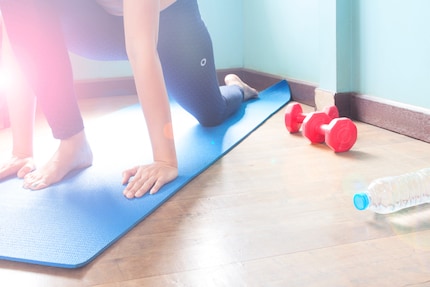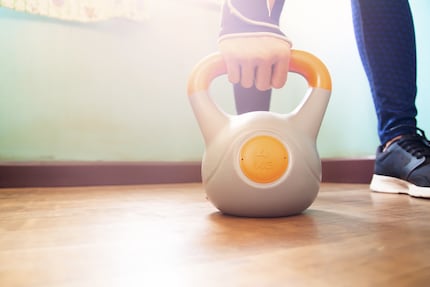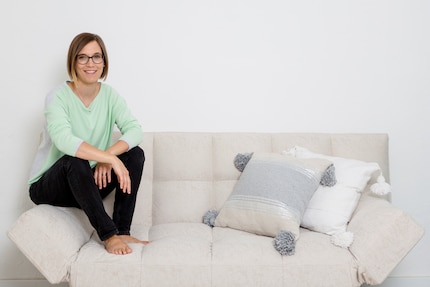
Guide
«No menstruation, no human beings»
by Natalie Hemengül

It’s not just in elite sport that it makes sense to adjust your workouts according to your period. In everyday exercise, a cycle-oriented approach helps you to get more out of your training. I called in an expert to explain how it works.
It’s actually a paradox. You’re always fine-tuning movements and performance in order to get the most out of yourself during a workout. You do everything to make yourself that little bit faster and stronger. When it comes to equipment, you only buy the best. And yet, you ignore an essential piece of the puzzle: your menstrual cycle.
It’s long been known that periods have an impact on mood and performance. But very few women integrate this knowledge into their workout.
Top female athletes are adjusting their training to their menstrual cycle bit by bit. For instance, skier Michelle Gisin now knows exactly when she’ll be affected by hormonal dips. «I need a lot of sleep around the time of my period. And I get stomach problems just before ovulation. In the last week of my cycle, my hips are unstable. And if I overdo it, I get floored by stomach cramps,» she recently said in the paper «NZZ am Sonntag» (article in German).
Meanwhile, Pascale Widmer firmly believes it’s important that professional athletes talk openly about the subject, both in terms of general awareness and creating an easy way to talk about the topic in popular sport. As a menstrual cycle advisor and nutritionalist, Pascale is often asked for cycle-specific workouts. Alongside her coaching business, she also gives regular talks on the subject (site in German). She points out that «a lot of women don’t even know where they are in their cycle right now. As a result, they can’t work out why it puts a strain on their workout. Or why they can suddenly do a lot more than a few days ago.» That’s why she says the menstrual cycle is such a great tool for diagnosing how your body is doing at any given time. And for helping you train in a more targeted way.
Pascale Widmer recommends keeping a menstrual cycle journal so you can spot patterns. Simply put, your body goes through different seasons during your four-week cycle. You can then use this pattern to create an individual monthly plan. Afterwards, Pascale gives workout and nutrition tips for each individual phase.
The cycle starts on the first day of menstrual bleeding. That’s when the body sheds about 80 ml blood from the uterus lining. During this time, womb muscle contractions can cause abdominal pain. Your hormone levels are low and so is your mood. You may feel worn-out and not have as much energy as usual. This phase lasts about four to seven days.
How should you train?
It’s OK to do exercise in this phase, but it’s best to avoid workouts that are very intense. Strength training and HIIT (high intensity interval training) «are of no use to the body,» explains Pascale Widmer. Instead, she recommends yoga, gentle endurance training, stretching or going for a walk. In other words, «do what feels good».
What should you eat?
You want to be eating nutritious food to make up for all the nutrients excreted in your menstrual blood. Foods high in iron are important at this time, for example meat or seeds, nuts and vegetables such as spinach and broccoli. Healthy fats such as omega 3 fatty acids are perfect. You can find them in nuts, seeds and plant oils. Meanwhile, magnesium helps alleviate stomach cramps. So, if you have chocolate cravings, it’s best to reach for something that’s got a high percentage of cocoa.

Your body is preparing for the next ovulation. The uterus lining renews, the follicle-stimulating hormone FSH is produced and promotes the production of oestrogen in the ovaries. When this is paired with testosterone, your body gets a powerful combination. You feel full of energy and have plenty of drive. This phase lasts about five to eight days.
How should you train?
«This is when workouts such as strength sports and HIIT are worthwhile. Your muscles now have a stronger reaction to training stimulation,» explains Pascale. In other words, you can go all out three or four times a week. Your immune system is at its best, your metabolism is enhanced and your oestrogen levels protect you from injury. The peak in performance comes to an end not long after ovulation.
What should you eat?
High-fibre foods, such as wholegrain products, nuts and vegetables are the order of the day. Because the exercise you’re doing is intense, you’ll also need enough carbohydrate and protein. «Bitter foods also help support the liver,» she points out. For example, rocket, herbs and broccoli.
In the ovulation phase, the concentration of luteinising hormones (LH) and oestrogen in the blood continues to increase until the follicle bursts and the mature egg is pushed out of the ovaries. You feel euphoric, extroverted and sociable. This phase lasts three to five days.
How should you train?
«Let how you’re feeling guide you,» advises Pascale. «You’ll get maximum energy just before ovulation. But it’s important to seize the moment and use it accordingly.» If you miss it, you can easily injure yourself. Because your body is preparing for a would-be pregnancy, your tendons and ligaments will be particularly supple, which increases the risk of injury. Reaction training is too risky right now. Listen to your body. «As soon as you notice a drop in energy, you should reduce your workout intensity.»
What should you eat?
High-fibre foods similar to those recommended in «spring» or the follicular phase are a good bet. «We often have a reduced appetite at this time and have to make sure we eat enough,» says Pascale.

After ovulation, the empty follicle shell, which is known as the corpus luteum, produces the progesterone hormone to build up the uterus lining again and prepare for a potential egg implantation. At this time, you may experience premenstrual syndrome (PMS), have a tight feeling in your breasts, feel bloated and irritable. Your energy levels change by the day. Just before your period, you’ll experience a low point because your body needs energy to prepare for bleeding. This phase lasts about 12 to 16 days.
How should you train?
Less often and not as strenuously. You’ll sweat for longer and your body will need more time to recover. What’s more, your coordination will get worse. «At this time, I’d recommend endurance sports, strength training and lots of recuperation,» says Pascale. However, you won’t be able to build muscles in this phase. Because your ligaments and tendons are so supple, there’s a high risk of getting injured. «It’s also because we can’t control our muscle groups in as targeted a way.»
What should you eat?
Given your increased calorie consumption, you’ll also now need more energy. That’s why complex carbohydrates such as wholegrain pasta, rice or potatoes can help to keep your blood sugar level stable. With less oestrogen as an immune booster, you’ll need more vitamin C and zinc. Meanwhile, L-arginine in the form of nuts, seeds, meat and eggs or as a supplement can help with mood swings.
| Phase | Duration | Training |
|---|---|---|
| Menstruation | 4 to 7 days | Easy endurance training, yoga, stretching |
| Follicular | 5 to 8 days | Intense strength training, HIIT |
| Ovulation | 3 to 5 days | First intense, then adjust intensity to the decreasing energy level |
| Luteal | 12 to 16 days | Lower intensity strength training, relaxed recovery runs |
Rigid training and meal plans might work in high-performance sport. But it can risk putting non-professional athletes off at first. And make alarm bells ring for mothers in particular. They may be thinking how on earth am I supposed to make that work day-to-day when family commitments determine when I can train and meals are dictated by what the kids like to eat. «It’s just a matter of getting used to it,» explains cycle expert Pascale, herself a mother of two young children. «You eventually get into a routine.»
Nowadays she automatically knows which day of her cycle she’s on and can respond accordingly. That doesn’t mean she manages to live in harmony with her cycle every day: «I always let myself fall into traps.»

But in the meantime, she’s developed some tricks to help in her day-to-day life. In terms of food, for instance, she cooks meals a few days in advance and then freezes them to make sure she has nutritious food during her period. Pascale says that stews are great for this.
Pascale had to learn to have less demands put on her during this time.» Even from her family. There aren’t going to be well-balanced, imaginative meals for the children while she’s on her period. Just as there aren’t going to be so many big trips or strenuous workouts. Her family knows this – and they also know that later on in the second or third phase, she’ll have time to catch up. «Everyone ends up benefiting in the end.»
Skier Michelle Gisin is also a proponent of this method: «Ignoring your hormonal cycle is a lot more unpleasant in the long run than it is to talk about it,» she pointed out in «NZZ am Sonntag». Nowadays she makes use of her hormonal fluctuations and exploits her positive phases in a very targeted way. «After my period I’m Superwoman. I can take advantage of the hormone peak to lift weights for two weeks.» Ever since she began adapting her workouts to her cycle, her strength training has become even more efficient.
Mom of Anna and Elsa, aperitif expert, group fitness fanatic, aspiring dancer and gossip lover. Often a multitasker and a person who wants it all, sometimes a chocolate chef and queen of the couch.
Practical solutions for everyday problems with technology, household hacks and much more.
Show all